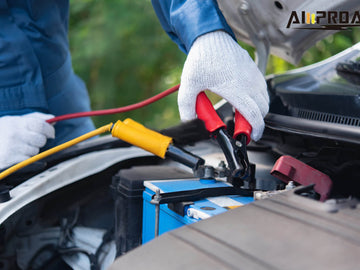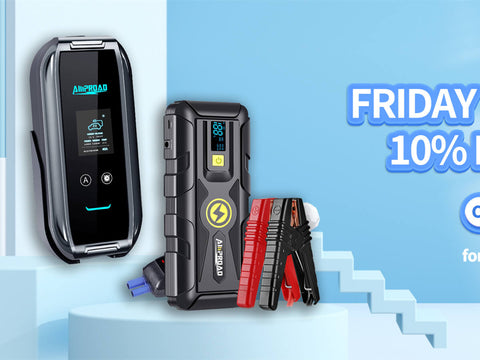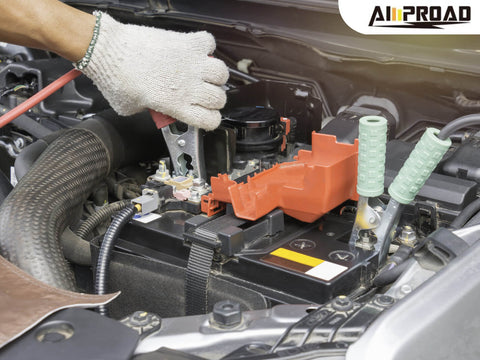
Jump starters are portable devices designed to provide a boost of power to a vehicle's battery, allowing it to start when the battery is dead or discharged. They are commonly used in emergency situations when a vehicle's battery fails to start the engine.
Imagine you're stranded in a deserted parking lot late at night, your car refusing to start. This scenario is all too familiar to many drivers, highlighting the common need for jump starters in emergency situations.
However, an important question arises: Can a jump starter with lower voltage output still be effective in such emergencies? We'll delve into this query, exploring the risks, considerations, and safety implications associated with using a jump starter with lower voltage output when faced with a dead battery emergency.
How to Understand the Jump Starters?
Explanation of How Jump Starters Work
Jump starters are portable devices designed to provide a temporary boost of power to a vehicle's battery, allowing it to start the engine. They work by delivering a surge of electrical energy to the battery, which provides the necessary power to turn over the engine. This surge of energy can overcome the resistance in a discharged or depleted battery, enabling the vehicle to start.
Jump starters typically consist of a battery pack, cables with clamps, and various safety features such as reverse polarity protection. The battery pack stores electrical energy that is transferred to the vehicle's battery via the cables and clamps. When connected properly, the jump starter supplies the necessary voltage and current to the battery, initiating the starting process.
Overview of the Typical Voltage Output Range of Jump Starters
Jump starters come in various models with different voltage output ranges, typically ranging from 12 volts to 24 volts. The voltage output of a car booster pack determines its compatibility with different types of vehicles, as most vehicles operate on a 12-volt electrical system. Some heavy-duty vehicles, such as trucks or RVs, may require a jump starter with a higher voltage output to effectively start their engines.
Importance of Matching the Voltage Output of the Jump Starter to the Vehicle's Requirements
Matching the voltage output of the jump starter to the vehicle's requirements is crucial to ensure safe and effective jump starting. Using a jump starter with an incorrect voltage output can result in electrical damage to the vehicle's battery or electrical system. For example, using a jump starter with a higher voltage output than the vehicle's electrical system can cause overloading and damage to sensitive electronic components.
Conversely, using a jump starter with a lower voltage output may not provide enough power to start the vehicle's engine, resulting in unsuccessful jump starting attempts. Therefore, it's essential to verify the voltage requirements of your vehicle and select a jump starter with a compatible voltage output to avoid potential damage and ensure successful jump starting.
So, understanding how jump starters work and matching their voltage output to the vehicle's requirements are essential for safe and effective jump starting. By following these guidelines, drivers can confidently use jump starters to boost their vehicles' batteries in emergency situations, ensuring a swift and reliable solution to starting issues.
Are There Any Risks and Considerations Using a Jump Starter with Lower Voltage Output?

Discussion on the Risks Associated with Using a Jump Starter with Lower Voltage Output
When considering how to boost a car, using a jump starter with lower voltage output poses significant risks. The primary risk is that the lower voltage may not provide sufficient power to start the vehicle's engine, especially if the battery is severely depleted or the engine requires a higher voltage to turn over. This can result in unsuccessful jump starting attempts, leaving the vehicle stranded and requiring alternative solutions for starting.
Potential Consequences of Mismatched Voltage Output, Such as Damage to Vehicle Electronics or Battery
Mismatched voltage output between the jump starter and the vehicle's electrical system can have serious consequences. If the jump starter delivers insufficient voltage to start the engine, repeated attempts to jump start the vehicle may strain the battery and electrical system, potentially causing damage to vehicle electronics or the battery itself. Additionally, if the voltage output is too low, it may not provide enough power to operate essential vehicle systems, such as the fuel injection or ignition system, leading to further complications.
Importance of Considering Safety and Potential Long-term Damage When Using Jump Starters
When faced with a dead battery emergency, it's essential to prioritize safety and consider the potential long-term damage associated with using jump starters with lower voltage output. While using a battery booster with a lower voltage may seem like a quick fix in the moment, it can result in costly repairs or replacements down the line if it causes damage to vehicle electronics or the battery. Therefore, it's crucial to weigh the risks and benefits and explore alternative solutions, such as contacting roadside assistance or seeking professional help, to ensure a safe and effective resolution to the starting issue.
Emergency Scenarios
Exploration of Potential Emergency Scenarios Where Using a Jump Starter with Lower Voltage Output May Be Considered
In emergency scenarios such as being stranded in a remote area with no access to immediate assistance or during inclement weather conditions, using a jump starter with lower voltage output may seem like a viable option to jump-start a vehicle's battery. Additionally, situations where a higher voltage jump starter is unavailable or inaccessible may prompt consideration of using a lower voltage alternative.
Evaluation of the Risks Versus Benefits in Each Scenario
While using a jump starter with lower voltage output may provide a temporary solution in emergency situations, it's essential to weigh the risks against the benefits. The main risk is the potential for the jump starter to be ineffective in starting the vehicle's engine, leading to prolonged downtime and the need for alternative solutions. On the other hand, the benefit of using a lower voltage jump starter is the convenience of having a portable and accessible solution on hand in emergency situations.
Recommendations for Alternative Solutions in Emergency Situations
Considering the risks associated with using a jump starter with lower voltage output, it's advisable to explore alternative solutions in emergency scenarios. One alternative is to contact roadside assistance or emergency services for professional help and assistance. Roadside assistance services are equipped with the necessary tools and expertise to jump-start vehicles safely and efficiently, minimizing the risk of damage to vehicle electronics or the battery. Additionally, carrying a portable battery booster pack or maintaining a set of jumper cables in the vehicle can provide alternative means of jump-starting a vehicle in emergencies, without the risk of using a jump starter with lower voltage output.
Safety Tips and Best Practices

Before using a jump starter, it's crucial to follow safety tips and best practices to ensure a smooth and secure jump-starting process.
Tips for Ensuring Safe Jump Starting Procedures
When using a jump starter, safety should always come first. Before connecting the jump starter, inspect it and the cables for any signs of damage or wear. Ensure that both vehicles are turned off and in park or neutral. Connect the positive (+) clamp of the jump starter to the positive terminal of the dead battery first, then attach the negative (-) clamp to a metal surface away from the battery to avoid sparks. Start the vehicle with the charged battery and let it run for a few minutes before attempting to start the vehicle with the dead battery. Disconnect the jump starter cables in reverse order.
Best Practices for Selecting and Using Jump Starters in Emergency Situations
When selecting a jump starter for emergency situations, opt for a high-quality, versatile portable jump starter like AMPROAD. These jump starters are compact, lightweight, and equipped with advanced safety features, ensuring reliable performance during emergencies. Consider factors such as voltage output, peak current, and compatibility with your vehicle's battery type. Ensure that the jump starter is fully charged before use and keep it stored in a convenient and accessible location in your vehicle.
Importance of Reading and Following the Manufacturer's Instructions
Regardless of the jump starter you choose, it's essential to read and follow the manufacturer's instructions carefully. Each jump starter may have specific operating procedures and safety precautions that need to be followed for optimal performance and safety. Failure to adhere to the manufacturer's instructions could result in damage to the vehicle's battery or electrical system, as well as potential safety hazards. By reading and following the instructions, you can ensure the safe and effective use of your jump starter in emergency situations.
Ensuring Safe Jump Starting: The Importance of Correct Voltage Output
Throughout this article, we've explored the functionality of jump starters, the importance of understanding their voltage output, and the risks associated with using a jump starter with lower voltage output in emergency situations.
Using a jump starter with lower voltage output poses significant risks, including ineffective jump-start attempts, potential damage to vehicle electronics or the battery, and prolonged downtime. Mismatched voltage output can lead to safety hazards and costly repairs, highlighting the importance of selecting the correct voltage output jump starter for your vehicle.
In emergency situations, it's crucial to prioritize safety and ensure the effective jump starting of your vehicle. We strongly recommend using the correct voltage output jump starter compatible with your vehicle's requirements to mitigate risks and ensure a safe and reliable resolution to starting issues. By selecting the appropriate jump starter and following safety procedures, you can confidently address dead battery emergencies and minimize the risk of damage to your vehicle's electrical system.
FAQs / People Also Ask
Q: Can I use a jump starter with lower voltage output if my vehicle's battery is dead?
A: While it may seem like a quick solution, using a jump starter with lower voltage output can be risky. It may not provide enough power to start your vehicle's engine, potentially causing damage to the battery or electrical system.
Q: What are the risks of using a jump starter with lower voltage output?
A: The main risks include ineffective jump-start attempts, potential damage to vehicle electronics or the battery, and prolonged downtime. Mismatched voltage output can lead to safety hazards and costly repairs.
Q: Are there any situations where using a jump starter with lower voltage output is acceptable?
A: It's generally not recommended to use a booster batterie with lower voltage output. However, in some emergency situations where no other options are available, it may be attempted cautiously, recognizing the associated risks.
Q: How can I ensure a safe jump-starting process in an emergency?
A: To ensure safety, always use the correct voltage output jump starter compatible with your vehicle's requirements. Follow proper jump-starting procedures, inspect the jump starter and cables for damage, and prioritize safety at all times.
Q: What should I do if I don't have a jump starter with the correct voltage output?
A: In such cases, it's best to seek alternative solutions such as contacting roadside assistance or emergency services. They have the expertise and equipment to safely jump-start your vehicle without risking damage to your battery or electrical system.


